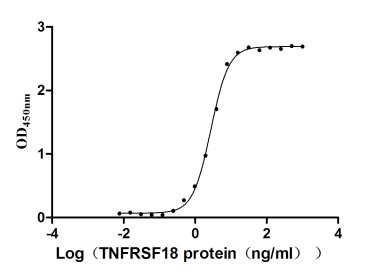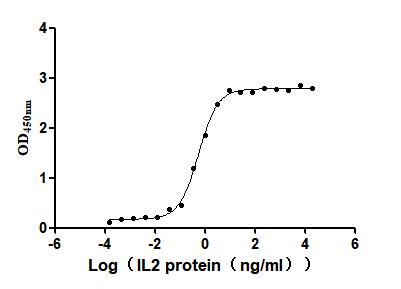Recombinant Mouse Mitochondrial brown fat uncoupling protein 1 (Ucp1)
-
中文名稱:小鼠Ucp1重組蛋白
-
貨號:CSB-CF025554MO
-
規格:
-
來源:in vitro E.coli expression system
-
其他:
產品詳情
-
基因名:
-
Uniprot No.:
-
別名:Ucp1; Slc25a7; Ucp; Mitochondrial brown fat uncoupling protein 1; UCP 1; Solute carrier family 25 member 7; Thermogenin
-
種屬:Mus musculus (Mouse)
-
蛋白長度:Full Length of Mature Protein
-
表達區域:1-307
-
氨基酸序列MVNPTTSEVQPTMGVKIFSAGVSACLADIITFPLDTAKVRLQIQGEGQASSTIRYKGVLGT ITTLAKTEGLPKLYSGLPAGIQRQISFASLRIGLYDSVQEYFSSGRETPASLGNKISAGL MTGGVAVFIGQPTEVVKVRMQAQSHLHGIKPRYTGTYNAYRVIATTESLSTLWKGTTPNL MRNVIINCTELVTYDLMKGALVNNKILADDVPCHLLSALVAGFCTTLLASPVDVVKTRFI NSLPGQYPSVPSCAMSMYTKEGPTAFFKGFVASFLRLGSWNVIMFVCFEQLKKELMKSRQ TVDCTT
Note: The complete sequence may include tag sequence, target protein sequence, linker sequence and extra sequence that is translated with the protein sequence for the purpose(s) of secretion, stability, solubility, etc.
If the exact amino acid sequence of this recombinant protein is critical to your application, please explicitly request the full and complete sequence of this protein before ordering. -
蛋白標簽:N-terminal 10xHis-tagged
-
產品提供形式:Liquid or Lyophilized powder
Note: We will preferentially ship the format that we have in stock, however, if you have any special requirement for the format, please remark your requirement when placing the order, we will prepare according to your demand. -
緩沖液:Lyophilized from Tris/PBS-based buffer, 6% Trehalose, pH 8.0
-
儲存條件:Store at -20°C/-80°C upon receipt, aliquoting is necessary for mutiple use. Avoid repeated freeze-thaw cycles.
-
保質期:The shelf life is related to many factors, storage state, buffer ingredients, storage temperature and the stability of the protein itself.
Generally, the shelf life of liquid form is 6 months at -20°C/-80°C. The shelf life of lyophilized form is 12 months at -20°C/-80°C. -
貨期:Basically, we can dispatch the products out in 1-3 working days after receiving your orders. Delivery time may differ from different purchasing way or location, please kindly consult your local distributors for specific delivery time.Note: All of our proteins are default shipped with normal blue ice packs, if you request to ship with dry ice, please communicate with us in advance and extra fees will be charged.
-
注意事項:Repeated freezing and thawing is not recommended. Store working aliquots at 4°C for up to one week.
-
Datasheet & COA:Please contact us to get it.
相關產品
靶點詳情
-
功能:Mitochondrial protein responsible for thermogenic respiration, a specialized capacity of brown adipose tissue and beige fat that participates in non-shivering adaptive thermogenesis to temperature and diet variations and more generally to the regulation of energy balance. Functions as a long-chain fatty acid/LCFA and proton symporter, simultaneously transporting one LCFA and one proton through the inner mitochondrial membrane. However, LCFAs remaining associated with the transporter via their hydrophobic tails, it results in an apparent transport of protons activated by LCFAs. Thereby, dissipates the mitochondrial proton gradient and converts the energy of substrate oxydation into heat instead of ATP. Regulates the production of reactive oxygen species/ROS by mitochondria.
-
基因功能參考文獻:
- This study highlights the novel mechanism of HDAC3-regulated Ucp1 expression during beta-adrenergic receptor stimulation. PMID: 30126161
- These findings suggested that HDAC6 contributes to mitochondrial thermogenesis in brown adipose tissue by increasing UCP1 expression through cAMP-PKA signaling pathway. PMID: 29890133
- Findings demonstrated that one bout of both uphill and downhill exercise trainings as well as 8 weeks of training could increase the expression of PGC-1alpha and FNDC5 genes in the muscle tissues and the UCP1 gene in the subcutaneous adipose tissue. PMID: 30218749
- To identify putatively causal regulators, we performed transcription factor binding site overrepresentation analyses in active chromatin regions and prioritized factors based on their expression correlation with the bona-fide brown adipogenic marker Ucp1 across multiple mouse and human datasets. PMID: 28181539
- Pyruvate induces torpor in obese mice. Pyruvate does not induce torpor in lean mice but results in the activation of brown adipose tissue with an increase in the level of uncoupling protein-1. PMID: 29311303
- striking reduction of mitochondrial electron transport chain components in mice genetically lacking UCP1 PMID: 28630339
- UCP1 cannot be fully inhibited by all adenine nucleotides tested. Phosphate is a novel inhibitor of UCP3 and UCP1. Conserved arginines in the PN-binding pocket are involved in the inhibition of UCP1 and UCP3 to different extents. Fatty acids compete with all PNs bound to UCP1. PMID: 29212043
- UCP1 mRNA expression is increased significantly with 10 muM of ACTH. PMID: 28375845
- Data suggest that triiodothyronine and high glucose signal coordinately to up-regulate ChREBP, Ucp1, Glut4, and Fasn in brown adipocytes; ChREBP plays role as a central regulator of brown adipocyte activity/energy metabolism. (ChREBP = carbohydrate-responsive element-binding protein; Ucp1 = uncoupling protein-1; Glut4 = facilitated glucose transporter-4; Fasn = fatty acid synthase, type-I) PMID: 29077876
- expressed in tail sebaceous glands; data do not support a thermoregulatory role PMID: 26914475
- UCP1 expression under inflammation is mediated by the increased expression of DBC1, which inhibits SIRT1 activity. PMID: 28481291
- MKK6 acts as a repressor of UCP1 expression, suggesting that its inhibition promotes adipose tissue browning and increases organismal energy expenditure. PMID: 29021624
- we find that rapamycin inhibits mTORC1 but not mTORC2, leading to suppression of elevated lipolysis and restoration of thermogenic protein UCP1 levels, respectively PMID: 27926859
- mTORC1 mediated many of the beneficial actions of FGF21 in vitro, including UCP1 and FGF21 induction, increased adiponectin secretion, and enhanced glucose uptake without any adverse effects on insulin action. PMID: 27681418
- Thus UCP1-dependent diet-induced thermogenesis limits obesity development during exposure to obesogenic diets but does not prevent obesity as such PMID: 28679625
- This study demonstrated that elimination of the gene expressing uncoupling protein-1 (UCP1), the enzyme responsible for thermogenesis, prevented musculoskeletal hyperalgesia in response to either a swim or BRL37344. PMID: 27437788
- Aortic UCP1 content was greater in females than males and its deletion improved ex vivo aortic vasomotor function in females only. Constitutive UCP1 content in BAT was similar between females and males and loss of UCP1 did not abolish sex differences in insulin sensitivity. Metabolic disruptions caused by UCP1 ablation did not appear to be contingent upon increased oxidative stress in mice under normal dietary conditions. PMID: 28655717
- Gelidium elegans stimulates the expression of PRDM16 and UCP-1 Protein in brown adipose tissue and suppresses hyperglycemia in high-fat diet mice. PMID: 28358328
- through interaction with Zfp516, LSD1 is recruited to UCP1 and other brown adipose tissue-enriched genes. PMID: 27264172
- Together the data show that both UCP1 and UCP3 play essential and complementary roles in thermogenic responses in the mouse and suggest that UCP3-dependent thermogenesis is an under-appreciated mode of thermogenic energy dissipation. PMID: 27647490
- in vitro experiments show that Arrdc3-null adipocytes responded to beta-adrenergic receptor agonist with decreased Ucp1 levels PMID: 28291835
- Despite the absence of UCP1 in the majority of epididymal beige adipocytes, these cells employ prominent creatine cycling as a UCP1-independent thermogenic mechanism. PMID: 28380374
- These novel findings uncover a previously unrecognized metabolic protective role of UCP1 that is independent of its already established role in energy homeostasis/ PMID: 27881400
- human and rodent Brown adipose tissue have similar UCP1 function per mitochondrion. PMID: 27508873
- Targeted mitochondrial uncoupling in adipose tissue and skeletal muscle of UCP1-transgenic mice increased substrate metabolism and ameliorates obesity. (Review) PMID: 27916644
- In the absence of regulators (fatty acids, retinoids), rodent UCP1 presents a high ohmic proton conductance that cannot be detected in human UCP1. PMID: 27750036
- The uncoupling of oxidative phosphorylation through a proton conductance pathway across the mitochondrial inner membrane is the mechanism for heat production in brown adipose tissue regulated by UCP1. (Review) PMID: 27621146
- Brown adipocytes trough their unique mitochondrial UCP1 protein burn glucose and lipids to perform thermogenesis in order to survive in cold environments. (Review) PMID: 27622583
- Brown and beige adipose tissues activate UCP1 protein in dissimilar fashion in response to cold temperature and depending on adipocytes differentiation state. PMID: 28109720
- ATGL activity is required for UCP1 activation in intact adipocytes. (Review) PMID: 27986537
- Metabolically inert perfluorinated fatty acids directly activate brown adipose tissue UCP1. PMID: 26041126
- Mice acclimatized to thermoneutrality revealed that Cpt2A-null interscapular brown adipose tissue failed to induce the expression of thermogenic genes such as Ucp1 and Pgc1a. PMID: 26854223
- Data show that fish oil intake increased oxygen consumption and rectal temperature, with concomitant upregulation of mitochondrial uncoupling protein 1 (UCP1) and beta3 adrenergic receptor (beta3AR). PMID: 26673120
- Skin temperature in the interscapular region of neonates was lower in uncoupling protein 1 knockout pups employed as a positive control, but not in Cox7a1 knockout pups PMID: 26635001
- PKA-dependent IRE1alpha-XBP1 activation is crucial for the transcriptional induction of Ucp1 in brown adipocytes. PMID: 26568450
- FGF21-mediated improvements in clearance of a glucose challenge require UCP1. PMID: 26586424
- antioxidant chemicals (such asN-acetylcysteine and Mn(III)tetrakis(4-benzoic acid)porphyrin chloride) and SB203580 (a known suppressor ofUcp1expression) decreasedUcp1and oxygen consumption inNrf2-deficient fibroblasts PMID: 26841864
- Data suggest beta-adrenergic activation of brown adipocytes leads to dissociation of Hdac1 from promoters of Ucp1/Pgc1a, to up-regulation of histone H3 acetylation, to dissociation of polycomb repressive complexes, and to up-regulation of thermogenesis. PMID: 26733201
- thermogenic mitochondrial reactive oxygen species alter the redox status of cysteine thiols in brown adipose tissue to drive increased respiration, and that Cys253 of UCP1 is a key target PMID: 27027295
- abundance decreased even more in cold-acclimated UCP1 knockout mice PMID: 26518386
- These data indicate that several important metabolic endpoints of FGF21 are UCP1 independent PMID: 25956583
- Data suggest that expression of Ucp1 in skeletal muscle can be regulated by dietary factors; the prebiotic epilactose prevents high-fat diet-induced obesity apparently via up-regulation of Ucp1 expression in skeletal muscles and brown adipose tissue. PMID: 26395755
- Data indicate that uncoupling protein 1 (UCP1) is required for the dietary methionine restriction (MR)-induced increase in energy expenditure (EE) but not insulin sensitivity. PMID: 25742717
- UCP1 and SLN are required to maintain optimal thermogenesis and loss of both systems compromises survival of mice under cold stress PMID: 25825499
- improved metabolism produced by oral administration of resveratrol is, at least in part, associated with increased thermogenesis followed by high expression of UCP1 and SIRT1 PMID: 24468941
- An experimental model of sleep apnea produced changes in uncoupling protein-1 expression and adiponectin levels. These results confirm previous findings on the response of brown adipose tissue to intermittent hypoxia. PMID: 24337908
- Data indicate that uncoupling protein 1 (UCP1) is not involved in control of reactive oxygen species production in brown-fat mitochondria. PMID: 24769119
- Zfp516 directly binds to the proximal region of the UCP1 promoter, not to the enhancer region where other transcription factors bind, and interacts with PRDM16 to activate the UCP1 promoter. PMID: 25578880
- We also found elevated mRNA levels of UCP-1 and Cidea after exposure to T3. PMID: 24771016
- Data indicate that the mobilization of free fatty acids (FFAs) was observed in interscapular brown adipose tissue (iBAT) of wild-type (WT) and uncoupling protein 1 (UCP1)-knockout mice. PMID: 24343897
顯示更多
收起更多
-
亞細胞定位:Mitochondrion inner membrane; Multi-pass membrane protein.
-
蛋白家族:Mitochondrial carrier (TC 2.A.29) family
-
組織特異性:Expressed in brown adipose tissue.
-
數據庫鏈接:
Most popular with customers
-
Recombinant Human Tumor necrosis factor receptor superfamily member 18 (TNFRSF18), partial (Active)
Express system: Mammalian cell
Species: Homo sapiens (Human)
-
Recombinant Human Interleukin-2 (IL2) (Active)
Express system: Mammalian cell
Species: Homo sapiens (Human)













